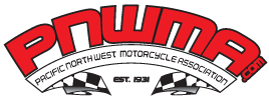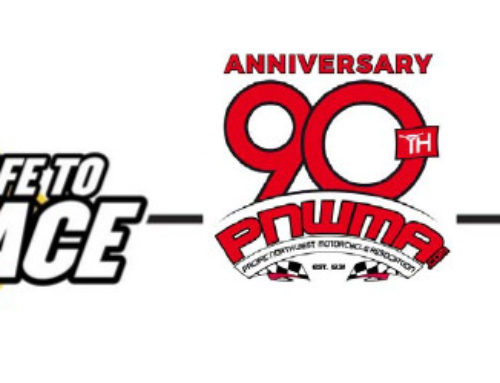Index
1) Arrow Specifications
2) Marking Trail
3) Marking Turns
4) Confidence Arrows
5) Wrong Way Markers
6) Danger Markers
7) Road Crossings
8) Splits
9) Checkpoints
10) Examples of Course Marking
0) Introduction
0.1) The following arrowing guidelines are intended as a reference to be used in arrowing race courses for the Pacific Northwest Motorcycle Association’s (PNWMA) Off-Road Series. They are provided to allow for consistent arrowing of race loops throughout the Off-Road Series and to provide reasonable guidelines for the methods to properly mark a race course.
1) Arrowing Specifications
1.1) The PNWMA does not recommend using ribbon as a source of marking, even for short sections of trail. Ribbons are widely used by the logging industry and other recreationists the ribbons that other groups have hung can be easily be confused with race course marking leading to competitors getting lost.
1.2) Mark the entire course with one colour of arrows, the preferred standard being black arrows on a florescent orange background.
1.3) Arrows should be placed every 100-300m (300-900 ft) max
1.4) Staple arrows to a tree trunk (not a branch) at all four corners to protect against curling from overnight dew.
2) Marking Trail
2.1) Arrows should be placed on the trail ahead of where the rider’s attention is focused. For example, in a bend to the left, the arrow should be placed on the right side of the trail (outside of the bend). Arrows should be placed slightly above eye level, preferable just out of reach of a person sitting on a tall bike.
2.2) Arrows should be then stapled straight up and down if the trail goes straight. They should be slanted slightly if the trail bends to the left of the right. Three arrows minimum should be used if the trail makes a “U” turn.
2.3) An arrow should be visible at each branch in a trail, at all trail intersections and all road intersections. Even if the trail continues straight, every time the trail goes past a branching trail or crosses a road, an arrow should be visible to a rider stopped in a fork in the trail.
2.4) When the course follows on trail or a road for a long distance, it is important that arrows are not placed more than 300m (900 ft) apart. This is even true if there are no crossings or forks in the course, these arrows serve as confidence arrows. The layout crew might know that the particular trails goes on forever, without any possibility of getting lost, but the event rider does not know that.
2.5) Where double course markings are used on both sides of the course, riders must stay between them (ie: four arrows, two on either side)
3) Marking Turns
3.1) A single arrow pointing down at a 45-degree angle should be placed in the direction of the approaching turn, approximately 30m (100 ft) before all turns. This arrow alerts the rider that a turn is approaching and enables them to get ready for the turn. This is called the “get ready to turn” arrow.
3.2) Two arrows should be placed at all turns at the exact location of the turn. They should point horizontally to the left or the right. These are actual “turn arrows”.
4) Confidence Arrows
4.1) The first “confidence arrow” should be posted immediately after each turn (approximately 15m (50 ft)) to assure the rider that they are on the course. The arrow should be visible to a rider in the intersection. The absence of this first “confidence arrow” is an immediate tip that you may be off course.
4.2) The second “confidence arrow” should be posted just out of sight of a rider in the intersection. This marker will help prevent vandals from disrupting a race.
5) Wrong Way Markers
5.1) Placement of “wrong way” markers is critical. A wrong way marker should be visible to a rider in the intersection. But if placed too near an intersection, they are easily missed because the rider’s attention is devoted to avoiding collisions at trail and road intersections. They must be placed where the rider’s attention is straight at them. The preferred standard for a wrong way marker is a black W on a white background.
5.2) Two wrong way markers should be placed at all wrong directions at all intersections, branching trails or any time a trail splits. One at the start of the wrong trail and at least one more 10m (30 ft) down the wrong trail. This will pay off in rider satisfaction.
5.3) Wrong ways may also be marked by stretching yellow ribbon across the trail above the height of a sitting rider and then tie ribbon to dangle from the original ribbon. This allows riders to see the ribbon and to avoid removing it if they blow the corner.
5.4) Also in the other direction, a “CAUTION Race in Progress” sign should be erected at all approaches to the race course. This is aimed at keeping non-competitors from mistakenly entering the course.
6) Danger Markers
6.1) Danger markers should be either an “X” or three “down arrows”. Where dangerous conditions exist, danger markers should be posted far enough in advance of the hazard to allow the fastest riders sufficient time to stop. They should be posted 15m (50 ft) before the danger or further if the speeds are higher. A second danger marker should be posted directly at the danger, and one “confidence arrow” should be posted where the danger has passed.
6.2) Also yellow ribbon may be used to mark out hazards. This is to be saved for very dangerous hazards. Ribbon marking should be used IN ADDITION to danger arrows.
6.3)Effort should be made to ensure there are no head-height logs, no butt—end logs protruding towards / into the trail (spears / joepokes / tall stumps), no logs on high speed sections, no unmarked cross ditches, etc. Min 3 ft clear tread except log obstacles in low speed technical sections.
7) Road Crossings
7.1) All road crossings should be manned. Mark all upcoming crossings with one or more danger markers 100m (300 ft) before the crossing, and another 5m (20 ft) before the road. Riders should dismount their motorcycles before crossing the road.
7.2) According to the British Columbia Motor Vehicle Act, licensed motor vehicles have the right of way over unlicensed vehicles.
8) Splits
8.1) If A/B splits are used during an event they must be posted, splits should be manned if possible. All splits must be marked as follows:
“A” Riders – Masters, Experts, Intermediates (3 hour riders)
“B” Riders – Veterans, Juniors, Women, Sportsman (2 hour riders)
8.2) A sign warning “A/B Split Ahead” should be placed 50m (150 ft) before the actual split.
8.3) At the split, two or more 60cm x 60cm (2’ x 2’) signs should be place stating “A SPLIT 3 HOUR RIDERS” and “B SPLIT 2 HOUR RIDERS” with directional arrows by each sign.
8.4) Confirmation signs stating “A RIDERS ONLY” and “B RIDERS ONLY” on the split trails shall be placed approximately 10 yards and 50 yards(where possible) past the split.
9) Checkpoints
9.1) Checkpoints should be marked at their location, so that riders understand that they have to stop for workers at the checkpoint. This is to distinguish between course workers at a road crossing and a checkpoint.
9.2) Checkpoints can be marked with a sign “CHECKPOINT” and white ribbon. There is no obligation to provide advance warning of a checkpoint.
9.3) It is not recommended to provide a dead check. All checks must be manned for sporting and safety purposes.
9.4) Checks must be located so that the riders pass directly by the check with no alternate route.



